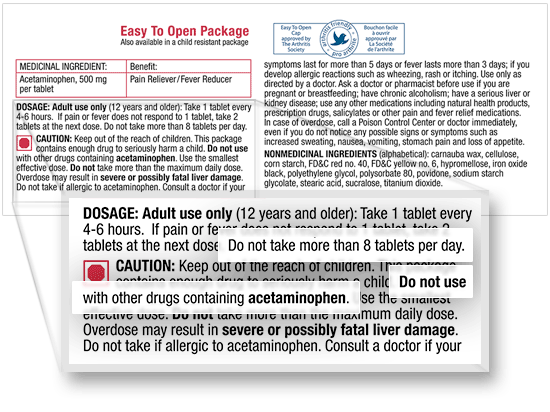Acetaminophen – Harm from Overdose Can Be Prevented
2014-02-06
Acetaminophen is a medicine used to treat pain and reduce fever. It is most commonly known by the brand name Tylenol, but it is also found in many nonprescription and prescription products with other names. Acetaminophen is safe and effective when it is used correctly. However, taking too much acetaminophen can harm your liver, possibly leading to liver failure or even death.
Through ISMP Canada's work with provincial coroners and chief medical examiners, SafeMedicationUse.ca has become aware of 2 fatal incidents involving acetaminophen. In each case, an adult died after taking too much acetaminophen. In one case, the consumer had been taking about 10 extra-strength acetaminophen tablets most days of the week. Each extra-strength tablet contained 500 mg of acetaminophen. This meant the consumer was taking 5000 mg (5 g) of acetaminophen per day. This is above the current maximum daily dose recommended for healthy adults in Canada. The consumer also drank alcohol, which increases the chances of harm to the liver.
Here are tips for consumers to help prevent harm when using medicines that contain acetaminophen:
-
Do not exceed the recommended maximum daily dose of acetaminophen. The maximum daily dose is the total amount of a medicine that a person can safely take in one day. Information about the maximum daily dose of nonprescription products may be indicated on the label by wording such as "Do not take more than..." (see the example label in Figure 1). In Canada, the maximum daily dose of acetaminophen currently recommended for healthy adults is 4000 mg (4 g) per day.* However, the amount of acetaminophen that you can safely take each day may be lower, depending on your age, medical conditions, and the amount of alcohol you consume.
-

-
Figure 1- Example of Extra Strength Tylenol medicine label
(Image courtesy of Johnson & Johnson Inc.)
- When purchasing a nonprescription medicine, carefully read the label, including the list of ingredients. Check for "acetaminophen" in this list. If you need help, ask your pharmacist.
- Avoid taking more than one product that contains acetaminophen at the same time, unless you have been advised to do so by your prescriber or pharmacist. Be aware that acetaminophen may also be an ingredient in prescription medicines such as Tylenol #3, Percocet and others. Acetaminophen is also known as "paracetamol" or "APAP".
- Check the strength of acetaminophen in the product that you are taking. This will usually be labelled in milligrams (mg) for tablets and as milligrams per millilitre (mg/mL) or milligrams per 5 millilitres (mg/5 mL) for liquids.
- Keep track of the amount of acetaminophen you take each day. Check the time when you take each dose.
- If you use any form of acetaminophen, make sure to include this on your list of medicines and to share this list with your care providers.
- If you drink alcohol, ask your healthcare provider for assistance in choosing a dose of acetaminophen that is safe for you. The maximum daily dose recommended on the label of nonprescription acetaminophen products may cause liver damage in people who consume alcohol regularly.
- The amount of acetaminophen for a child under the age of 12 (including the maximum daily dose) is best determined using body weight. Ask your healthcare provider for assistance in choosing the correct dose of acetaminophen for a child. Several acetaminophen products are available for children, with different names (such as Tempra, Tylenol, or a store brand) and in different strengths. It is important to choose a product that is suited to the dose required. Know the maximum number of doses that may be given safely to your child in a 24-hour period, and do not exceed this amount.
- Always use a proper measuring device when taking or giving a liquid form of acetaminophen. See more about using liquid doses.
- In situations where someone has taken more than the recommended daily dose of acetaminophen, call your local poison information centre for advice. The sooner you seek medical help, the better the chance of getting effective treatment and surviving an overdose. Poison Centres in Canada Contact Information.
For more information, read our articles about brand names and acetaminophen.
|
Tips for Practitioners
- Before prescribing or recommending any product containing acetaminophen, ask patients about their use of other products containing acetaminophen, and update patient records accordingly.
- When prescribing or dispensing prescription products containing acetaminophen, be sure that patients understand the importance of adhering to the recommended dosage schedule. Remind patients to carefully check the ingredients on all medication labels, because many nonprescription products contain acetaminophen along with other active ingredients.
- If patients are taking multiple medicines containing acetaminophen, help them to understand the total amount that can safely be taken.
- Ensure that parents and caregivers understand how to dose children's acetaminophen products.
- Ensure that weight-based doses are based on an accurate weight in the appropriate units (e.g., kilograms versus pounds).
|
*Labelled recommendations for the maximum daily dose of acetaminophen may differ outside Canada.
|

